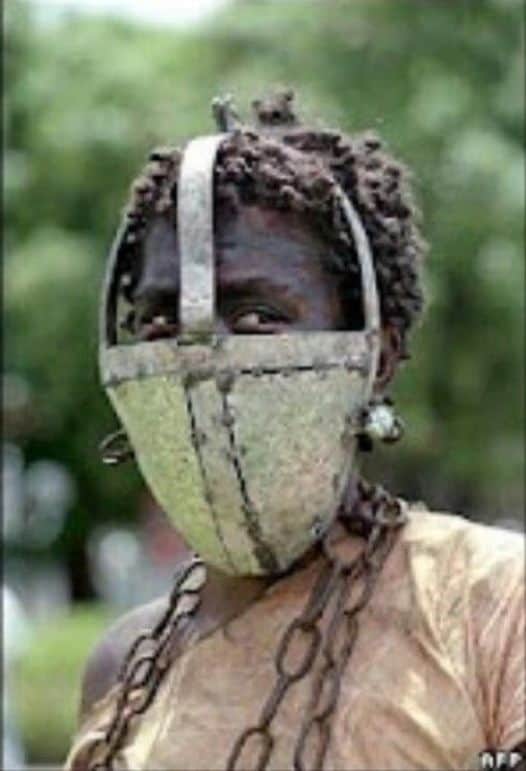The Horrifying Use of Metal Masks on Slaves

The use of metal masks on slaves is one of the more harrowing aspects of slavery’s dark history. This practice, which emerged prominently during the transatlantic slave trade, particularly in the 17th and 18th centuries, exemplifies the extreme measures slave owners employed to exert control, inflict punishment, and maintain power over enslaved individuals.
The metal masks were more than just tools of physical restraint; they symbolized the dehumanization and brutalization of enslaved people, reflecting a system that denied their humanity and reduced them to mere property.
Origins and Purpose of Metal Masks
Metal masks were often employed in the Americas, particularly on plantations in the Caribbean and the Southern United States, as well as in Brazil. These masks were designed to fit over the head and face of the enslaved person, covering the mouth and sometimes the entire face. They were made of iron or other heavy metals, crafted to be intentionally uncomfortable, and difficult to remove without the overseer’s assistance.
The primary purposes of metal masks were:
– Prevention of Speech and Communication: The masks prevented slaves from speaking, singing, or communicating with one another. This was particularly important to slave owners who feared rebellion or organized resistance. By suppressing communication, they aimed to maintain control and prevent the enslaved from plotting escapes or uprisings.
– Punishment for Eating or Stealing Food: One common use of the metal mask was to punish slaves who were caught eating crops, particularly sugarcane, which was a valuable commodity. By fitting a slave with a mask, owners could prevent them from consuming food without permission, thus exerting control over their diet and health.
– Symbol of Humiliation and Dehumanization: Beyond physical restraint, the masks served as tools of psychological terror. They were a public mark of shame, designed to humiliate the wearer and serve as a deterrent to others. The masks stripped individuals of their dignity and served as a constant reminder of their subjugated status.
– Control of Runaways and Disobedient Slaves: The masks were often used as punishment for slaves who tried to escape or disobey orders. By making the act of escape even more arduous and uncomfortable, slaveholders believed they could deter future attempts.
Design and Construction of Metal Masks
The metal masks were typically designed to fit tightly over the head and were sometimes equipped with iron spikes or other protrusions that caused additional discomfort. The masks would be locked in place, often with a padlock or a similar mechanism, making it impossible for the wearer to remove it without help. Some masks covered only the mouth and nose, while others enclosed the entire face, with small openings for the eyes, making breathing difficult and speaking impossible.
The masks were heavy and cumbersome, causing physical pain and fatigue. They were often designed with sharp edges that could cut into the skin, and in many cases, they led to infections, sores, and long-term facial disfigurement. In some instances, masks were equipped with metal bits that would rest in the mouth, further restricting the ability to speak and adding to the physical torment.
Psychological and Physical Impact on Slaves
The use of metal masks inflicted severe psychological and physical trauma on enslaved individuals. The constant weight and constriction of the mask were a source of persistent discomfort and pain. Physically, the masks could cause wounds, rashes, and breathing difficulties, and in some cases, they resulted in long-term disfigurement. The mental impact was equally devastating, as the masks served as a constant reminder of the slave’s lack of autonomy, their perpetual punishment, and the dehumanizing conditions under which they lived.
The public nature of the punishment also contributed to psychological harm. Enslaved individuals who were forced to wear masks became spectacles of humiliation, their suffering laid bare for others to see. This form of punishment reinforced the power dynamics of the plantation and served as a warning to others about the consequences of defiance.
A Legacy of Cruelty and Resistance
While the metal mask is a particularly disturbing symbol of slavery, it is also a testament to the resilience of the enslaved. Despite the extreme brutality and attempts to suppress their humanity, many slaves continued to resist in whatever ways they could. Acts of defiance, from small acts of rebellion to full-scale revolts, highlighted the enslaved individuals’ will to fight against their oppressors.
The legacy of the metal mask, like many other tools of slave punishment, serves as a stark reminder of the inhumanity of the slave trade. It underscores the lengths to which those in power went to control and dehumanize others, and it highlights the enduring impact of this cruelty on the descendants of those who were enslaved.
The use of metal masks on slaves is a tragic example of the extreme brutality that characterized slavery. These masks were more than just instruments of punishment; they were symbols of the dehumanizing nature of the slave system. Understanding this aspect of history is crucial, not just as a reflection of the past, but as a reminder of the ongoing need to confront the legacies of slavery and strive toward a more just and humane society. The pain and suffering caused by such devices are an indelible part of history, and they serve as a powerful testament to the resilience of those who endured and resisted against all odds.

